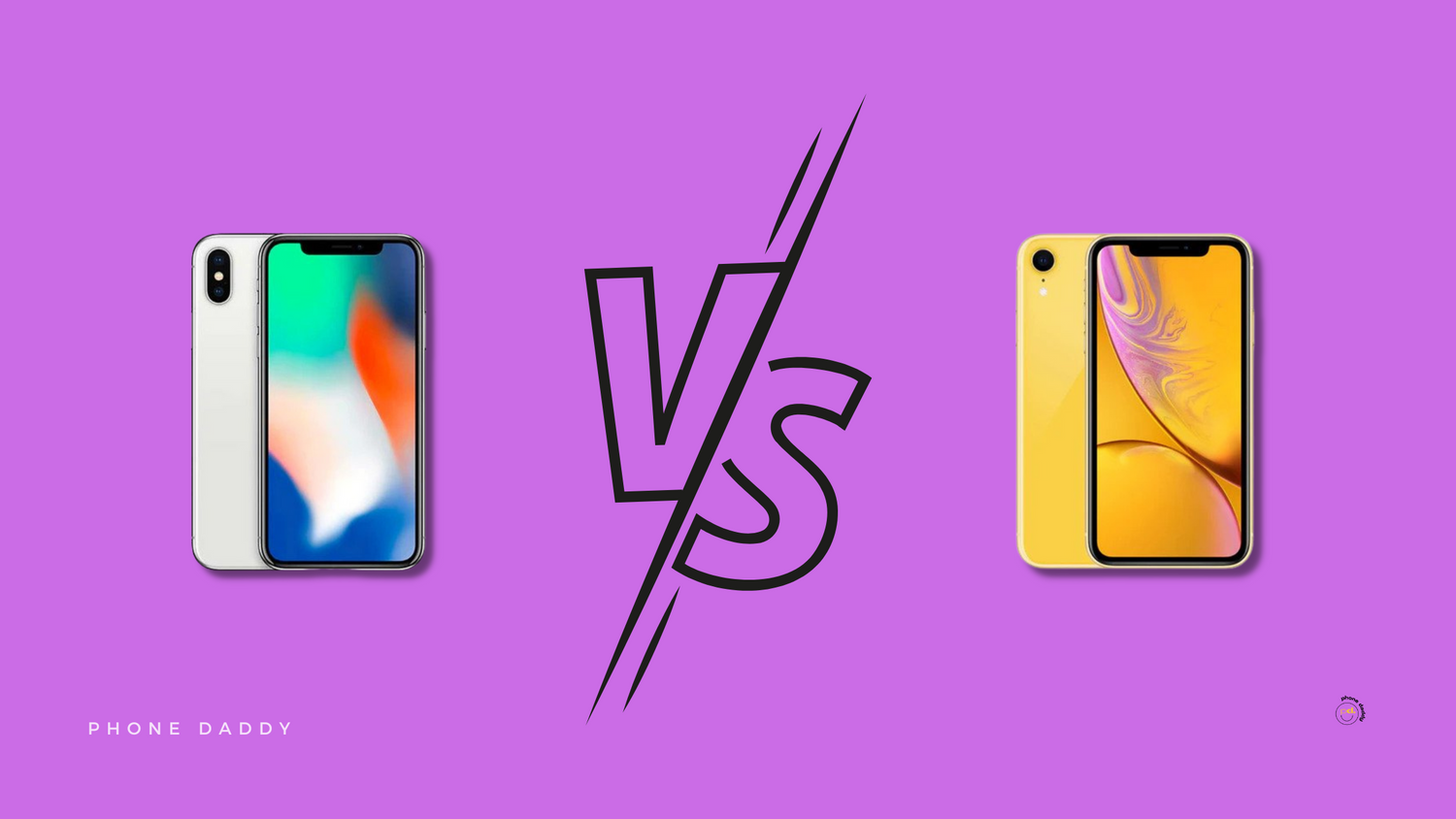- iPhone X and XR were released in 2017 and 2018, respectively.
- Despite being a few years old, both these iPhone models are in demand due to their high-end features, iOS compatibility, and affordability.
- Both iPhone XR and X have some significant differences despite being released only a year apart.
The iPhone X and iPhone XR are part of the high-end range of iPhones and come with premium features, such as facial recognition, practically bezel-less displays, and powerful processors. However, there are a few key differences between the two models that potential buyers should be aware of. In this article, we’ll explore the differences between the iPhone X and the iPhone XR in terms of design, display, performance, camera, and price. By the end of this comparison, you should have a good understanding of which phone is best suited for your needs.
iPhone X vs. iPhone XR: Specs
Below we have compared the specifications of the iPhone X with the iPhone XR:
|
Specifications |
iPhone X |
iPhone XR |
|
Display Size |
5.8 inches |
6.1 inches |
|
Display Type |
Super Retina OLED |
Liquid Retina IPS LCD |
|
Processor/Chipset |
Apple A11 Bionic (10 nm) |
Apple A12 Bionic (7 nm) |
|
RAM |
3 GB RAM |
3 GB RAM |
|
Internal Storage |
64GB, 256GB |
64GB, 128GB, 256GB |
|
Battery |
2716 mAh |
2942 mAh |
|
Camera |
Rear: 12 MP, f/1.8 (wide) 12 MP, f/2.4 (telephoto) Front: 7 MP, f/2.2 (standard) |
Rear: 12 MP, f/1.8 (wide) Front: 7 MP, f/2.2 (standard) |
|
Operating System |
iOS 11.1.1, upgradable to iOS 16.2 |
iOS 12, upgradable to iOS 16.2 |
|
Weight |
174 g |
194 g |
Hardware and Performance
The iPhone X is powered by the A11 Bionic chip, while the A12 Bionic chip powers the iPhone XR. Apple’s A11 is a 64-bit ARM-based processor introduced with the iPhone X in 2017. The A11 Bionic chip has six cores, including two high-performance and four energy-efficient cores. The A11 Bionic chip is known for its fast performance and ability to handle demanding tasks, such as gaming and augmented reality applications.
The A12 Bionic chip is also a 64-bit ARM-based processor introduced with the iPhone XR, iPhone XS, and XS Max. It has six cores, including two high-performance cores and four energy-efficient cores. The A12 Bionic chip is the first to be manufactured using a 7nm process, allowing more transistors to be packed into a smaller space, resulting in faster performance and improved energy efficiency.
The A11 Bionic and A12 Bionic chips are powerful processors offering excellent performance. However, the A12 Bionic chip is an improvement over the A11 Bionic chip in performance and energy efficiency.
In terms of performance, the iPhone X and iPhone XR are swift and smooth. They can handle most tasks with ease, including demanding games and apps. However, the iPhone XR has a slight performance edge due to its higher-capacity storage options.
Storage Capacity
In terms of storage, the iPhone X is available in two options: 64 GB or 256 GB. On the other hand, the iPhone XR is available in three storage options: 64 GB, 128 GB, and 256 GB. Whether you buy a new or used iPhone X or iPhone XR, you’ll get these storage options.
Although iPhone X and iPhone XR offer excellent hardware and performance, their primary difference is the storage capacity and battery life, with the iPhone XR having slightly more in both areas.
Display
The iPhone X and iPhone XR both have stunning displays. However, there are a few differences between the two displays. For instance, the iPhone X display extends to the phone’s edges, creating a bezel-less look, but the iPhone XR has the most bezel in the entire iPhone X series.
Size
The iPhone X has a 5.8-inch display, while the iPhone XR has a 6.1-inch display. This means that the iPhone XR has a slightly larger screen, which may be more appealing to people who like to watch videos or play games on their phones.
Resolution
The iPhone X has a higher resolution display (2436 x 1125 pixels) than the iPhone XR (1792 x 828 pixels). So, the iPhone X’s display is more detailed and has a higher pixel density, which may be more noticeable when viewing text or images up close.
Type
Apple’s bezel-less X is the first iPhone with an OLED screen, while the iPhone XR has an LCD display. OLED displays are known for their deep blacks and high contrast ratio, which can result in more vibrant and dynamic images. However, LCD displays are also known for their good image quality and can display colors accurately.
In summary, the iPhone X has a slightly smaller, higher resolution, and higher quality display than the iPhone XR. However, the iPhone XR’s larger display and good image quality may be more appealing to some users.
Design and Colors
The iPhone X has a glass back, while the iPhone XR has a glass front and a plastic back.
The iPhone X and iPhone XR have a similar design, with both phones featuring edge-to-edge displays and a notch at the top of the screen to house the TrueDepth camera system. The iPhone X has a glass front, a glass back, and a stainless steel frame, while the iPhone XR has a glass front and a glass back with an aluminum frame. The iPhone X is slightly smaller and lighter than the iPhone XR, weighing 174 grams compared to the iPhone XR’s 194 grams.
The iPhone X is available in two colors:
- Silver
- Space Gray
On the other hand, the iPhone XR is available in six colors:
- Black
- White
- Red
- Yellow
- Coral
- Blue
So, we have more iPhone XR colors to choose from. This may be appealing to users who want a phone with a more unique or personal look.
The iPhone X and iPhone XR have a similar design, with both phones featuring edge-to-edge displays and a notch at the top. The main difference is the material used for the phone’s frame and the number of color options available. The iPhone X has a stainless steel frame and is available in two colors, while the iPhone XR has an aluminum frame and is available in six colors.
Camera
The iPhone X has a dual rear camera setup, with a 12 MP wide-angle lens and a 12 MP telephoto lens. The wide-angle lens has an aperture of f/1.8, while the telephoto lens has an aperture of f/2.4. The dual rear camera setup allows the iPhone X to have 2x optical zoom and support for Portrait Mode.
Alternatively, the iPhone XR has a single rear camera, a 12-megapixel wide-angle lens with an aperture of f/1.8. The single rear camera does not have a telephoto lens and does not have optical zoom capabilities. Instead, it uses digital zoom, which can result in a loss of image quality.
Both iPhone X and XR have a 7 MP front-facing camera with f/2.2 aperture. For new buyers, the difference between a single rear camera and dual rear cameras may be a consideration when choosing between the iPhone X and iPhone XR. The dual lens on the iPhone X allows for 2x optical zoom and more accurate Portrait Mode results, while the single rear camera on the iPhone XR relies on digital zoom and software for Portrait Mode.
Battery Life and Charging
In terms of battery life, the iPhone XR has a slightly larger battery (2942mAh vs. 2716mAh on the iPhone X), and as a result, it tends to last longer on a single charge. However, both phones should be able to get through a full day of use with moderate to heavy usage.
Plus, both iPhones have wireless charging capabilities and are water-resistant (IP67 rating).
If you buy a used iPhone XR or iPhone X, make sure you check the phone’s battery power. As a rule of thumb, you should only buy a used iPhone with at least 80% battery health.
Price and Availability
Although Apple has discontinued the iPhone X and XR, you can easily buy used iPhone XR and iPhone X from different carriers and phone networks. If you are interested in purchasing a used or refurbished iPhone XR or iPhone X, you can check Phone Daddy’s collection. Remember that the availability and pricing of iPhone XR unlocked and iPhone X unlocked may vary from retailer to retailer.
Conclusion
The main differences between the iPhone X and iPhone XR features are the display size and resolution, rear camera setup, storage capacity, battery life, and color options. The iPhone X has a smaller, higher resolution, and higher quality display, a dual rear camera with 2x optical zoom, and a stainless steel frame.
Alternatively, iPhone XR has a larger, lower-resolution display, a single rear camera, and a glass front with an aluminum frame. Both phones have excellent performance and are considered mid-range smartphones. Potential buyers should consider these differences when deciding which phone suits their needs.


